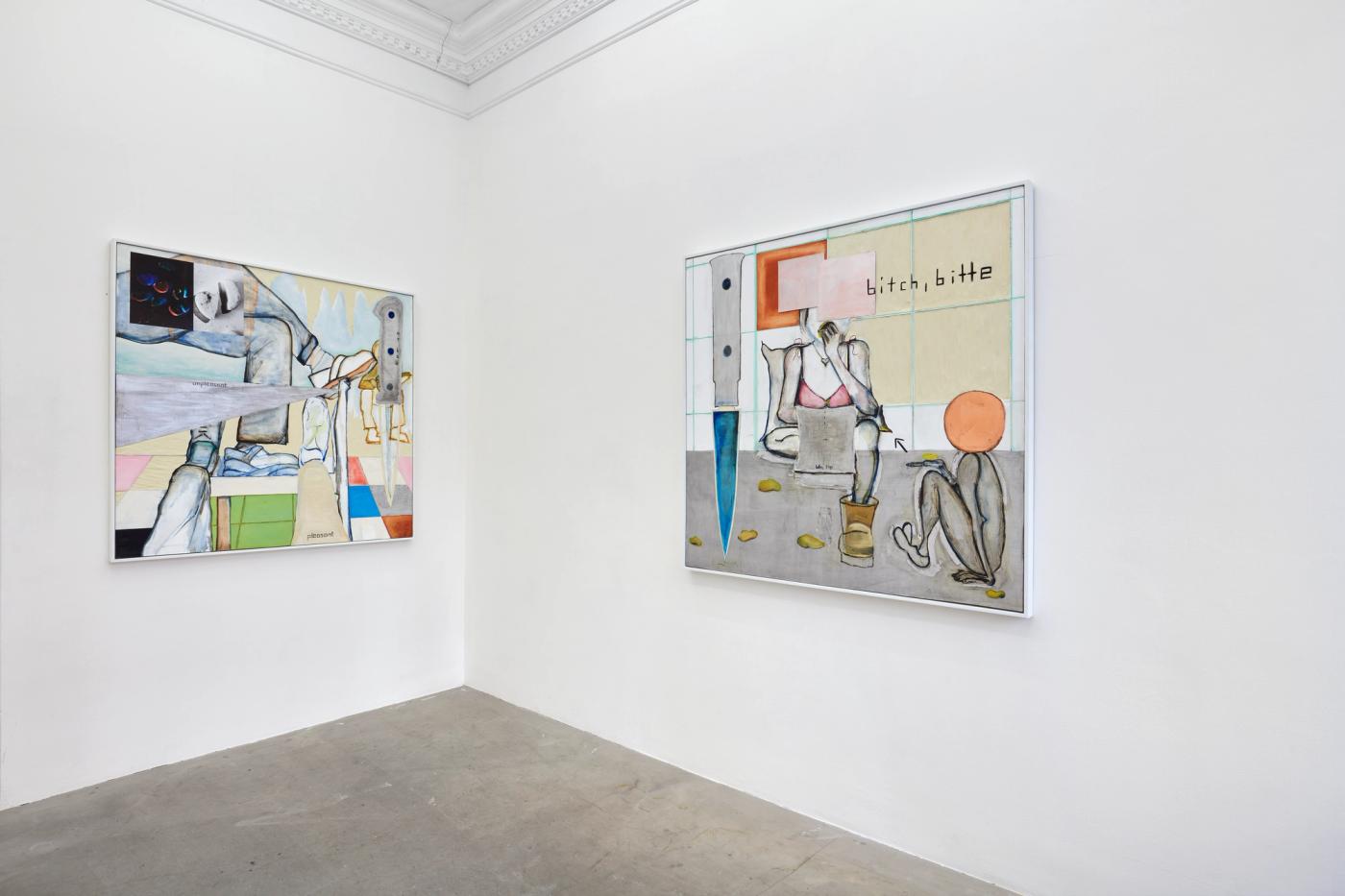
56 Henry is pleased to present Bitch, Bitte ! a solo exhibition of work by Dani Leder on view from March 9 through April 16, 2023. Bitch, Bitte ! is the artist’s first exhibition with 56 Henry.
Ambiguously spun figural assemblies characterize the two paintings in Dani Leder’s exhibition Bitch, Bitte !. These are not ennobling history paintings that impart lessons of morality or present sanctified subjects, but frank documents of social interactions, the “group dynamics” that occupy much of the artist’s thought and observations. As if arranging characters on a theatrical stage, Leder places her figures in moments of oppositional tension and confusion. In Candy Crush (2021), for instance, two pairs of dismembered limbs abut on a chair. But where one person should be sitting, they hover; where the other’s feet should be on the ground, they are propped up on the chair. Marinating on the subtext of body language, Leder diagrammatically considers where extremities will interact or repel, copulate or stray. These concise configurations recognize how seduction is encoded in the slightest of gestures––the hilt of a hip, the brush of a hand, the turn of a knee towards the object of desire. A set of collaged photographs of broken candy hearts, an upright knife, and a gestural silver triangle marauding as another abstracted blade suggest different means of figuring heartbreak through signs and forms. In turn, what Leder labels “nonsynonymous substitutes” help clarify the relationships between these autonomous, but intwined bodies.
And while Leder attends to the dynamics of flirtation, attraction and heartache, she also excavates the interiority of the individual––the way the self battles its own multiplicity. In Bite, Bitte (2021) the two bodies might indeed be representations of the same person. One, fully realized in its corporeality and expression of personal taste (a frilly bra with tiny bow, a heart necklace, platform Ugg boots), the other, a deprived surrogate, is physically and psychologically reduced to its most primal need. Here, a crouched figure with hand outstretched begs for an offering from its embodied counterpart’s fecund bag of potato chips. Perhaps representing the Freudian id––the crude, desirous quotient of the tripartite conceptual model––it might also suggest other parasitical and asymmetrical relationships like forms of labor or childrearing. In any event, closer examination reveals that the supplicant never receives the chip; it hovers above the hand, resisting satiation. Rhyming with the volumetric gap between the two forms in Alberto Giacometti’s Suspended Ball (1930-31), which has been theorized as a locus of unculminated sexual intercourse, the lacuna between hand and chip distills the sense of suspended desire that cradles Leder’s paintings. Urges increase with denial. Displeasure is riddled with pleasure and vice versa––just look to her dichotomous phrasing “unpleasant” / “pleasant” in Candy Crush.
Leder’s relational figures occupy environments that likewise structure and seduce. These spartan interiors are typically clad in tiled surfaces, evoking the art historical grammar of the grid and alluding to what the artist refers to as “wet infrastructure” ––public spaces like restrooms or industrial kitchens that are easily wiped down, thereby promising cleanliness to its users. Meanwhile the putative sterility of these rooms merely disguises the residue of impure activities (in a related series, Leder depicts brazen lovers engaging in public sex in bathroom stalls with bruises already forming on kneeling knees). Metals, like steel and aluminum, also ground her lexicon of suggestive surfaces. The recurrence of German knives across her oeuvre is especially charged––referencing their superlative quality, complicity in the tainted steel industry, and metonym for the supposed precision of the German citizen. Knives also recollect the artist’s use of scalpels to carve into her Corafoam support.
In Bite, Bitte, collaged panes of aluminum serve alternate functions, covering the face and creating a moment of hypostatized pause. Leder increasingly accompanies each figurative painting with a pared down monochrome, a means of literalizing a zone of rest and reflection that her constellation of signs and bodies often require (a kind of sympathetic coping mechanism). This syntactical strategy, in which materials substitute for emotions and fragmented limbs stand in for entire beings and yet still larger interpersonal sagas, illuminates the heuristic logic of Leder’s practice––painting as a system of knowledge or thought formation. In this way, the agonistic removal of the foam backing is understood as erasure and editing. Arrows and brackets map the consolidation and disarticulation of meaning. At the same time, her actual use of text is emphatically colloquial and punchy: “my bad” or “bitch, bitte” (“bitch, please” with a German twist). Fastidious analytical frames and fatalistic knives aside, this is tragicomedy––a world in which heartbreak and gluttonous want can be alleviated by a sheepish “my bad.”
— Megan Kincaid
Dani Leder (b. 1983, Frankfurt) lives and works in New York. Leder earned a PhD in Philosophy from NYU in 2013 and studied at the Städelschule in Frankfurt am Main from 2014 to 2017. In 2019, she received an MFA in painting from Bard College. Recent solo exhibitions include Conditions Gallery, Toronto; Downs & Ross, New York; Page (NYC), New York; and Neue Alte Brücke, Frankfurt. Group exhibitions include Petzel, New York )(2021); HKW Museum, Berlin (2021); Clima Gallery, Milan (2019); Off Vendome, New York (2017); and On Stellar Rays, New York (2016).